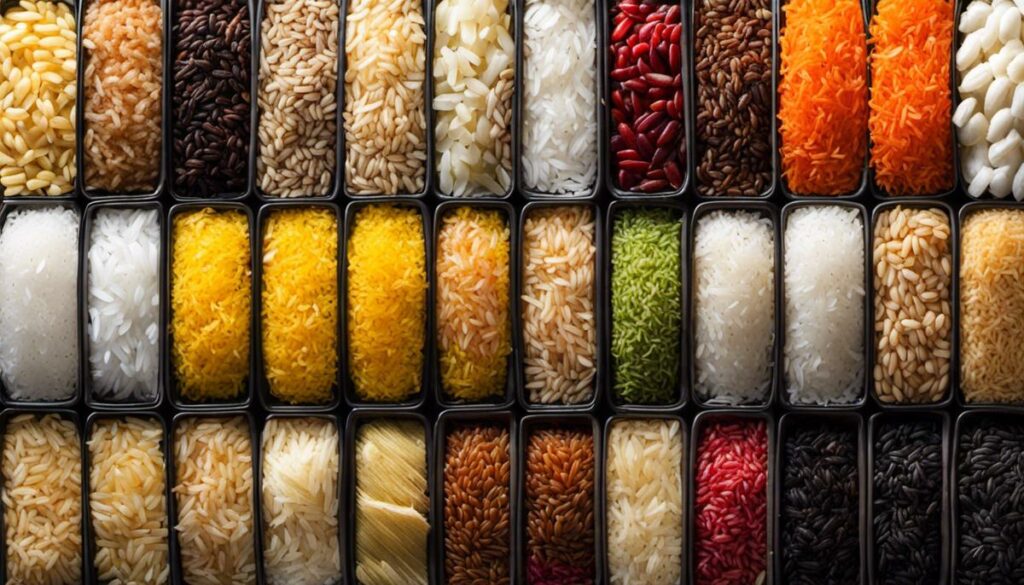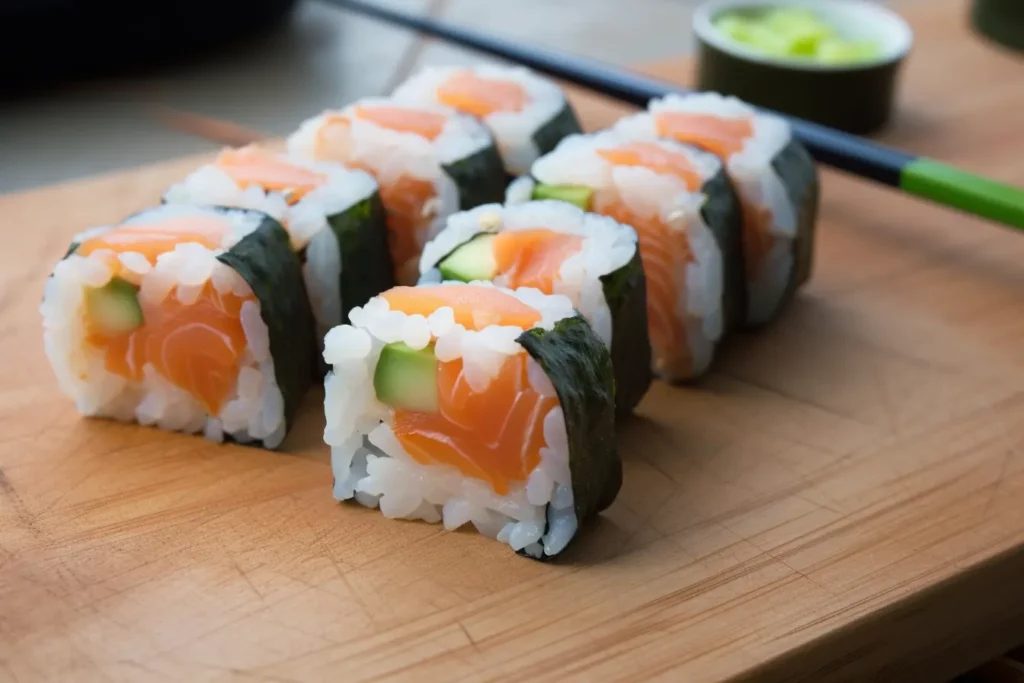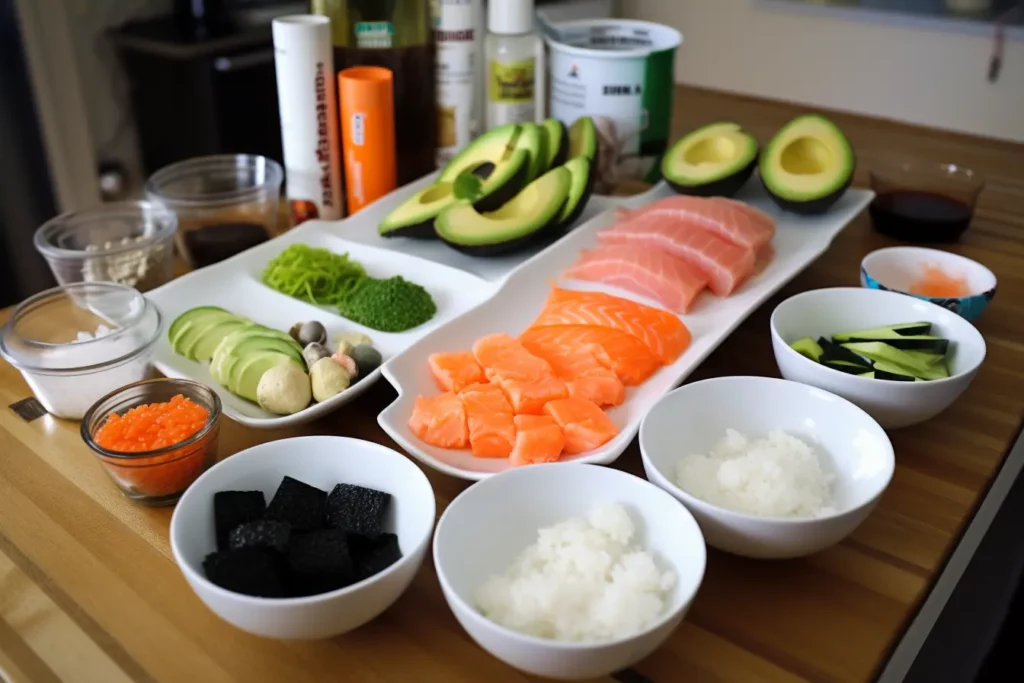The art of sushi is not only a culinary pleasure, but also a philosophy of life. It symbolizes the essential characteristics of Japanese culture: precision, artful aesthetics and the appreciation of fresh, high-quality ingredients. Whether you’re an avid home cook or a budding sushi master, to make sushi at home, you’ll need a specific selection of ingredients and utensils. From choosing the right rice, using fresh fish and seafood, the appropriate tools and utensils for preparing it, to artfully presenting and choosing suitable side dishes, there are many aspects to keep in mind. In this essay, we’ll walk you through these sushi basics and help you perfect your skills in preparing this iconic Japanese dish.
Choosing the right rice
We all know that sushi is an artful, delicate dish that has taken the world by storm. But have you ever wondered which types of rice are best for making sushi? It may probably surprise you to learn that not all types of rice are created equal, and some are definitely better suited to sushi than others.
Let’s start with the basis of all good sushi: short-grain rice. Unlike long- or medium-grain rice, the grains of short-grain rice varieties remain pleasantly firm and sticky after cooking, making them a bravura choice for sushi. Japonica rice, also known as Japanese rice, is one such variety and forms the irreplaceable base of most sushi variations.
However, not all japonica rice is created equal. In particular, Koshihikari rice is considered one of the best sushi trip par excellence. It is famous for its bright, neutral taste and particularly strong adhesive properties. The noble consistency of this rice, combined with its ability to bring out other flavors, makes it ideal for this culinary treat.
Want to try something different? Then you should take a look at sushiki rice. Sushiki rice has a much stronger character of its own than japonica rice, but brings an extra sophistication to your sushi. Its grains are smaller and softer, which adds an interesting extra layer of texture to your sushi.
Looking for something a little grainier? Why don’t you try black sushi rice? This rice has a nutty flavor and stays nice and firm after cooking. Black sushi rice offers not only a unique taste experience, but also an extraordinary visual experience.
As you can see, the possibilities are endless when it comes to choosing the right type of rice for sushi. Choose what suits you and your guests and let your creativity run wild when preparing the delicious rolls. Never forget: the best choice is always the one that flatters the palate and satisfies the stomach. So unpack the sushi maker and create culinary wonders in your own kitchen. You now know which types of rice are best suited.
Bon Appétit!
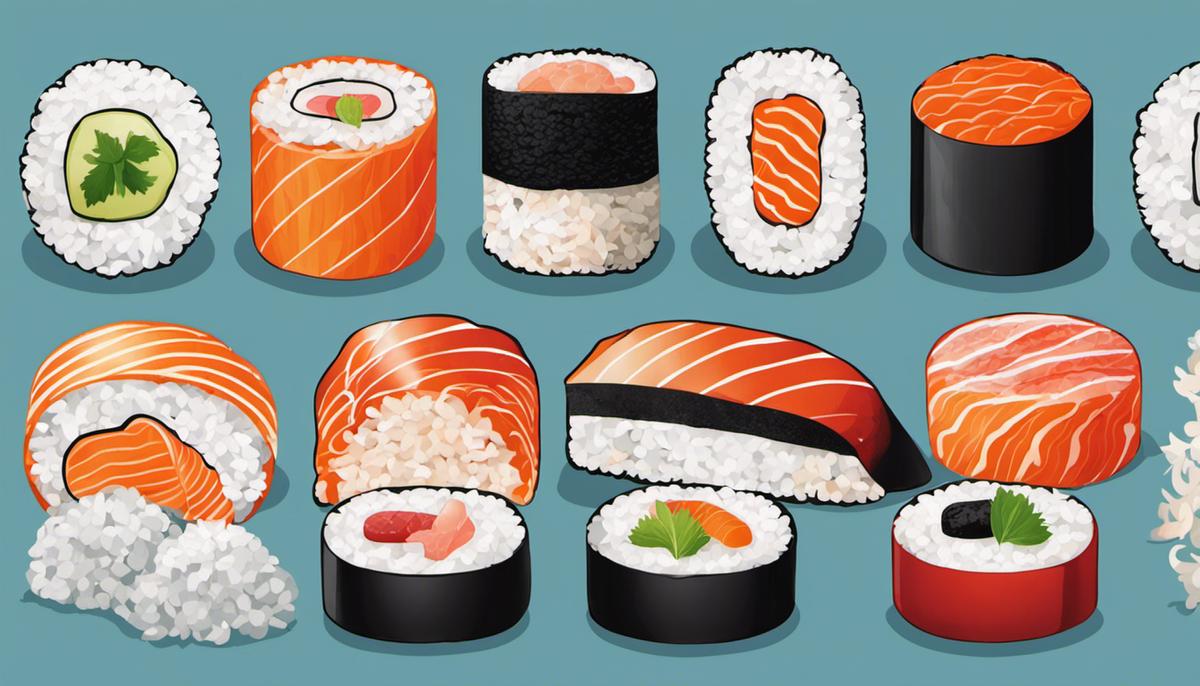
Use of fresh fish and seafood
Next, we turn our attention to the immaculate jewels of the seas: fish. With this knowledge, you as a foodie can expand your culinary skills even further and serve guests fresh and delicious sushi in style.
Recognising freshly caught fish is an art in itself. Choosing the most seductive fish begins with looking at the eyes. Are they clear and shiny? This is an unmistakable sign of freshness! Cloudy or sunken eyes, on the other hand, indicate older fish. Then you should inspect the skin and scales closely. They should look plump, moist and shiny, and the scales should adhere firmly to the skin.
Also pay attention to the scent. Fresh fish smells sweetly of the sea, but never fishy – a big, but often neglected aspect when choosing!
Body structure is also an important feature. Firm and elastic fish that returns to its shape when touched is your ideal candidate.
Now let’s prepare the fresh fish properly to create sushi at its best. An important utensil is a sharp knife. Invests in high-quality blades! They allow for precise cuts and ensure that your delicate fish are preserved.
First, the fish is deboned and the skin is carefully removed. The next step is to cut the fish lengthwise into thin strips – sashimi style, for all the sushi lovers out there. Always guide the knife in one direction and preferably with only one pull to ensure that the slices always stay nice and smooth and clean. This not only gives a taste bonus, but will also visually impress your guests!
Remember that skill and precision are the keys to success, and practice leads to mastery in any case. Experiment, hone your skills, and have fun hosting. It’s about enjoying the process and amazing your guests with your knowledge of everything from rice varieties to finely sliced, fresh fish.
This is not only a culinary adventure, but also a vibrant aesthetic and a delight for all the senses. Stay creative and let yourself be inspired by the natural charm of seafood.
Now, with these tips and tricks, you can navigate the world of fish. Be brave, try new things, and enjoy learning, experimenting, and of course, the delicious end product that rewards your efforts.
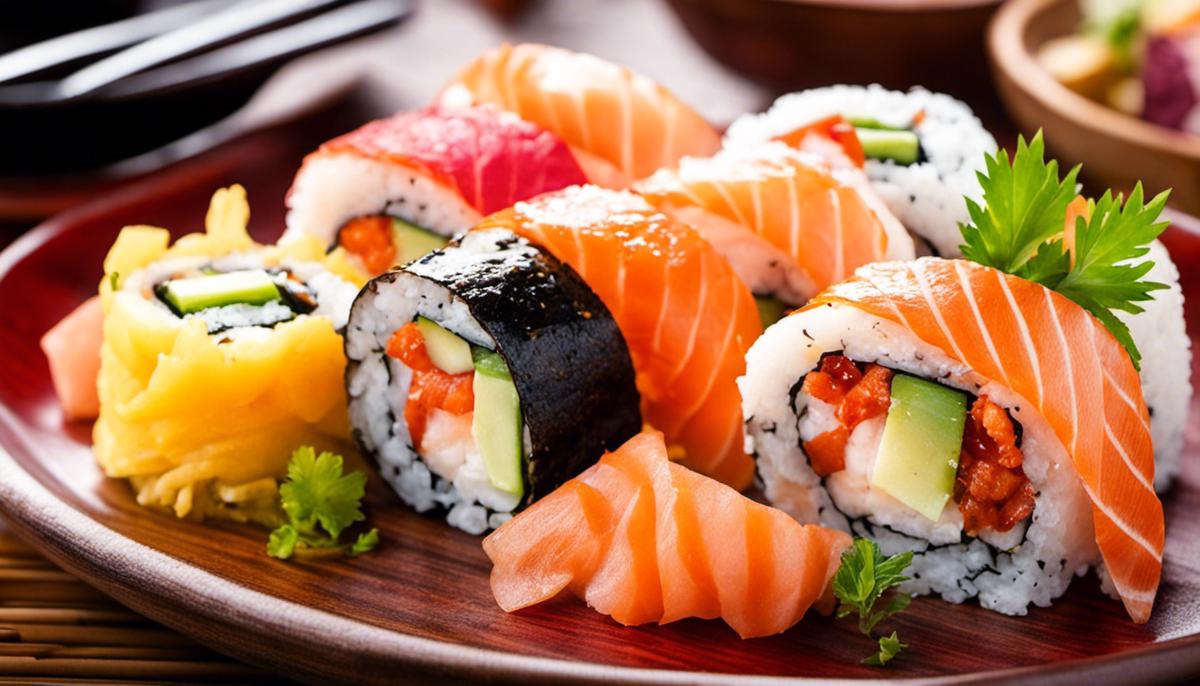
Tools and utensils for sushi preparation
Now that we’ve learned and mastered the world of rice and fresh fish for our homemade sushi, it’s time to focus on the necessary tools. Without the appropriate utensils, even the most ambitious chef will not be able to influence the final result. For example, it is important to focus on quality and sustainability when buying sushi tools.
The point of view should be focused on three essential utensils: A Makisu mat, a Hangiri bowl and a Yanagiba knife are indispensable and should not be missing in any quality-conscious kitchen.
The traditional Makisu mat, also known as the sushi mat, is an indispensable part of the preparation of sushi and should not be missing in any sushi tool collection. This bamboo tool helps press and shape the sushi roll and acts as a guide for the perfect cut. The small bamboo sticks of the Makisu mat are firmly attached to each other, so the sushi rice does not stick.
The hangiri bowl is the second important tool that should not be overlooked. It is a shallow bowl, usually made of pine wood, in which the rice is cooled and sushi vinegar is added. The heat of the wood helps to cool the rice faster and give it that unique, sticky texture, while the wood keeps the rice from drying out.
Finally, the star among the kitchen tools for sushi: the Yanagiba knife. This long, slender and, above all, sharp knife is essential for the perfect fish cut. Its unique length allows the fish to be cut in a single, smooth cut, which prevents the fish flesh from tearing and ensures the full integrity of the sushi piece.
All these tools together form the basis for the perfect sushi experience at home. They require practice and dedication to use successfully, but the effort is rewarded in delicious, aesthetically pleasing sushi rolls. And hey, don’t forget: taste and craftsmanship go hand in hand, and the perfect backdrop starts with the right tools. So, let’s get started and celebrate the art of sushi preparation at home!
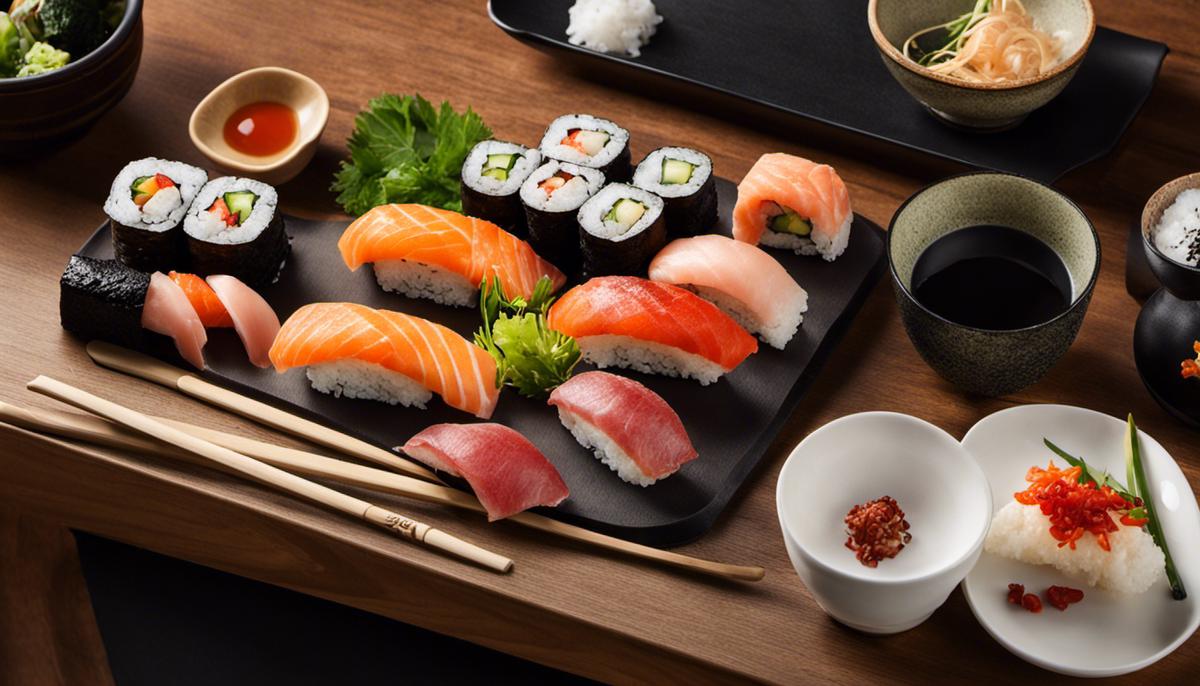
The Art of Sushi Arrangements
The Art of the Sushi Platter: Aesthetics and Arrangement in the Spotlight
We can say with certainty that in the world of sushi, as with so many things in life, the eye definitely eats with you. Nothing makes the culinary experience as unique as the loving display of our treats on the plate. So don’t just get stuck with sake or miso broth – creative flair and aesthetic sensitivity are particularly important when designing your sweet delicacies.
First of all, it is important to mention that the presentation of sushi does not have to follow strict rules. This is where the true art of the host lies: to have joy and, above all, fun in the design of the serving dishes and in the individual arrangement of the sushi variations!
But what if you’re not really a great artist and you’re sitting in front of an empty record, not quite knowing where to start? Well, it may take a bit of practice, but let’s give you some simple techniques and arrangements that can help create the perfect image.
Let’s start by choosing the right tableware. The color and shape of the plate plays an essential role in the sushi presentation. A white, square plate offers a minimalist aesthetic and sets the sushi as the focal point in a visually appealing way. Irregular fluted edges or an oval design add an additional playful touch and offer more space for experimentation.
Arrange your sushi rolls to give them extra volume. Both vertical and angled placements ensure that your creations look great from any angle. Be creative with your garnishes – think fresh herbs, pickled ginger, wasabi green dabs, or colorful caviar pearls.
Bring diverse textures to your sushi arrangement by adding crispy tempura crunches, velvety avocado strips, or fibrous julienned carrots. Color variations are also significant. A few red or yellow sashimi strips will work wonders and add contrasting accents.
Keep in mind that the free space on your plate is just as important as the space you fill with sushi. The rule here is: Less is more! Take to heart the principle of the “Ma,” a central aspect of Japanese aesthetics that emphasizes “spatial period” or “emptiness.”
Finally, create contrast and dynamism by arranging the reels at different angles, heights, and directions. Always remember that sushi is more than a food: it’s a form of art. And at the end of the day, the most important thing about our sushi compilation is the pleasure of eating. So go ahead and keep trying new arrangements, be creative and play with colors and textures. You’ll be amazed at how much the presentation enhances your dining experience.
Then let your culinary masterpiece speak for itself and enjoy the delicacies that you have so lovingly created. Because ultimately, that’s exactly what this art form is all about: the harmony of taste, texture and visual presentation, which together create an unparalleled sensory experience. It’s up to you to bring this experience to life with every bite.
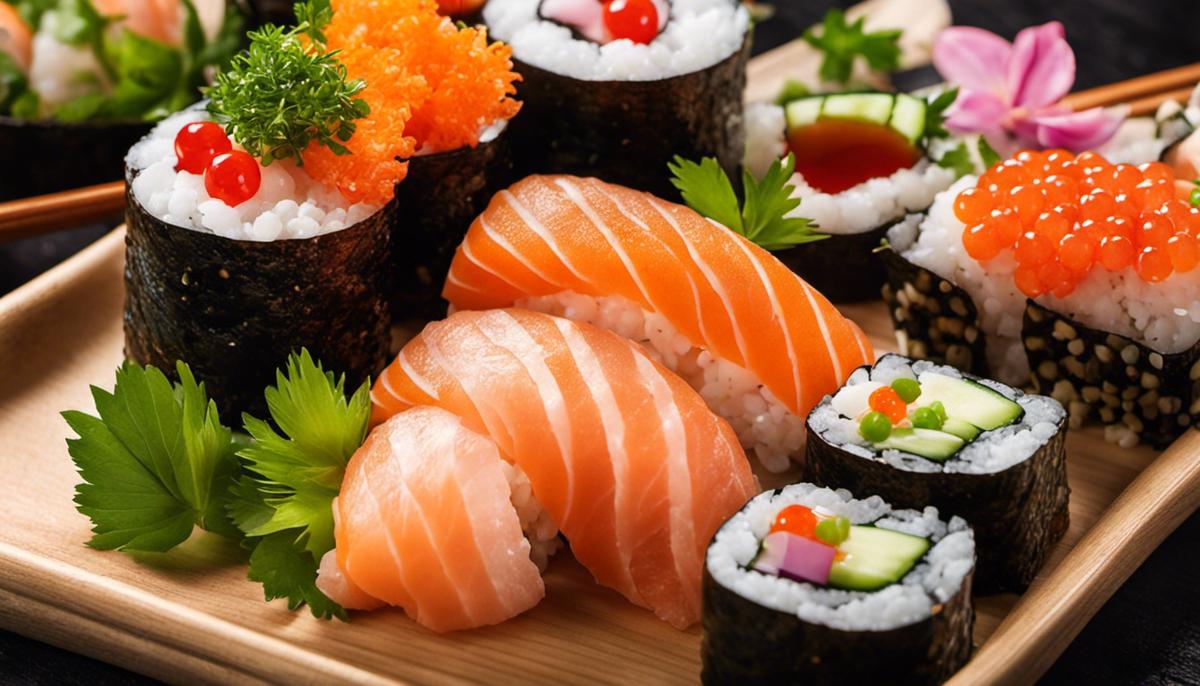
The selection of suitable side dishes and sauces
Now that all the important aspects for the preparation of an exquisite sushi dish have been considered, the selection of the perfect side dishes and sauces cannot be missing.
Side dishes and sauces are an integral part of the sushi experience, complementing not only the flavor but also the aesthetics of the dish. Let’s start with the classic gari, the pickled ginger. It is traditionally enjoyed between bites to cleanse the palate and bring out the flavor even more intensely. Its bright pink color is the aesthetically pleasing contrast that any sushi dish deserves.
Another indispensable element is the famous soy sauce. A hint of good soy sauce brings out the subtle nuances of taste. While some prefer the salty, deep flavor of the dark soy sauce, others choose the light soy sauce with its milder and sweet note.
Another regular guest is, of course, wasabi. The green, spicy paste can not only invigorate the taste buds, but also offers a beautiful color highlight. Just like with soy sauce, quality is key with wasabi, as real wasabi has a naturally subtle flavor and isn’t too spicy.
Don’t forget the wakame, a seaweed salad that enchants both taste and eyes with its fresh, almost lemony flavor and bright green color.
And finally, a roll of Alla California can’t do without the fluffy avocado cream, which gives the whole thing a sumptuous gourmet touch.
For those who want to go daring, try ponzu – a citrus soy sauce – or a silky sesame sauce. The sweet and gooey unagi sauce, which is made with soy sauce, sugar, and mirin, is another option for those who love an explosion of flavor.
Before concluding, it is worth noting that the aesthetic presentation of these side dishes and sauces also makes a difference. Experiment with small bowls, interesting serving platters, and colorful backgrounds to elevate your sushi platter.
So, it’s time to get out your sushi tools, choose your favorites among the side dishes and sauces, and embark on a truly enjoyable and visually stunning sushi experience. Have fun!
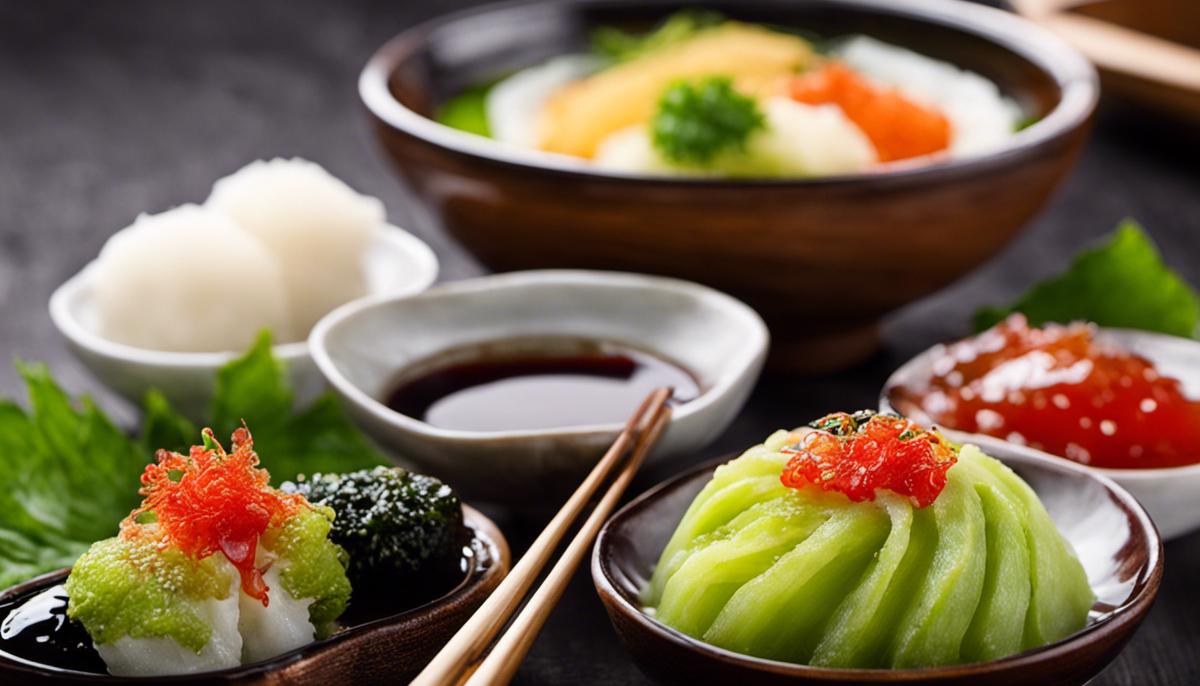
There is no doubt that the preparation of sushi is an art in itself. It requires precision, care, and a deep appreciation for the ingredients used. However, once you’ve mastered the basics and are ready to dig into more specific techniques and presentations, making sushi becomes an inspiring and rewarding experience. Every aspect, from the selection of the rice, the cutting of the fish, to the artful arrangement, helps to make every portion of sushi special. But what counts in the end is your enthusiasm and interest in this wonderful cuisine. So, make your sushi roll experience special and let your creativity run wild. Have fun rolling sushi!
